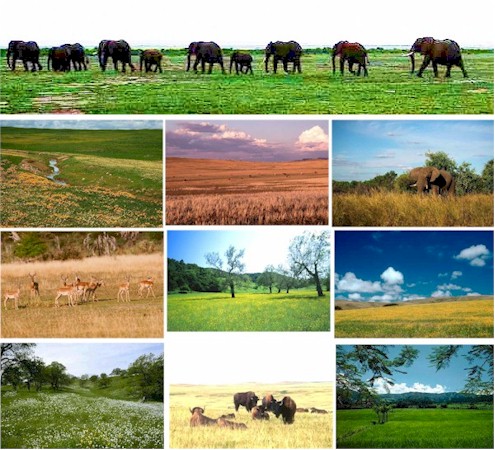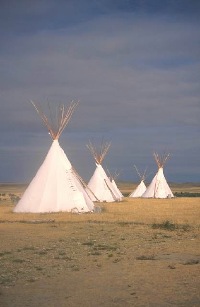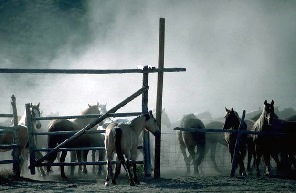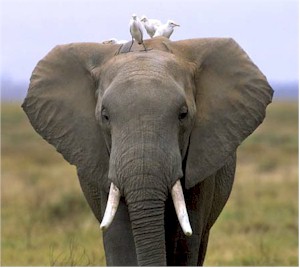|
Eco-Pros GRASSLANDS
The Story of the catastrophic 8-year
drought and great dust storms The vast grasslands of the Great Plains and the Great Basin in the United States were once inhabited by many different Indian tribes and abundant wildlife. 20 million bison thundered across the plains, which the Indians depended upon for food and clothing. Some described it as "great herds of buffalo as far as you could see." Then the Homestead Act of 1862 brought 6 million settlers, and so began one of the worst environmental disasters in world history.
The land became so damaged there was very little to harvest, so thousands of farmers and ranchers left to seek their fortunes elsewhere. Many continued west into California. It is estimated that some 50 million acres of land were damaged and 50 million more endangered. The worst damage occurred in Oklahoma, Kansas, Colorado, Texas and New Mexico. You can see that because of the improper intervention of humans in converting the natural grassland ecosystems into grain crops, allowing the remaining grasslands to be overgrazed, and not using proper farming methods, the land was unable to withstand such a long drought period and unusually severe wind storms. The government set up programs to help restore the land, and they taught the remaining farmers how to protect the soil and slow erosion. The settlers began to restore and protect the land, and they planted trees as windbreaks. The land, the Indians, the settlers, and the bison species had all suffered greatly, and harsh lessons had been learned.
Around the world
in many countries, people are still suffering, species are in decline, the
weather is becoming more severe, and ecosystems are being decimated. We
now know that starvation, disease, war, environmental damage and devastation of
biodiversity in any one area of the planet affects the sustainability of the
whole living system. All of our ecosystems, whether they be rainforests,
coral reefs, glaciers, wetlands, temperate forests, coasts, watersheds, or
grasslands - all are systems that have developed over centuries and thousands of
years, and they are what have allowed life to flourish on this Earth. All
species, both discovered and as yet undiscovered, play a crucial role in
the survival of other species. We have learned some hard lessons - but we
are learning, and many efforts are underway around the world to help our fellow
human beings and the environment of our living planet. The Dust Bowl - Dust Bowl photos from the U.S. National Archives.
Excerpts from "The
Dust Bowl, Men, Dirt and Depression" by Paul Bonnifield
"Surviving the Dust Bowl" -
PBS
Prairie
Links Grasslands - Fact Sheet from South Africa
Neotropical Grassland Conservancy - Learn about grassland types and tropical savannas. See definitions for some related words and view map of Grasslands of South America by type. Bell LIVE!
Presents "On
the Prairie" New
World Resources Institute Report Shows Striking Declines in World’s Grasslands
Grassland
Grasslands
- Savannas, temperate grasslands, and steppes Seas
of Grass and Who
Lives in Grasslands? Managing
Large Grasslands for Grassland Birds Kansas
Wildflowers and Grasses National
Grasslands Tallgrass
Prairie National Preserve "The stunning hills
and vistas in this region of Kansas are a rare remnant of the vast expanse of
tallgrass prairie that once covered much of central North America." |
|||||||
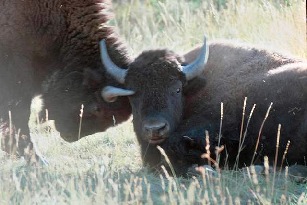 |
Home, Home on the Range
Oh give me a home where the buffalo
bison roam
Where the deer and the antelope play
Where seldom is heard a discouraging word
And the skies are not cloudy all day
Home, home on the range
Where the deer and the antelope play
Where seldom is heard a discouraging word
And the skies are not cloudy all day
- author unknown
Scientifically, the
American Buffalo is named Bison.
It belongs to the Bovidae family of mammals, as do domestic cattle.
We'll be
bringing you more information soon about the
world's grasslands and their inhabitants.
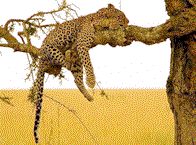
Meanwhile this leopard is going to take a nap.
| Speaking of naps, we
must have been napping when we referred to this big cat as a
cheetah. Clayton Pope, wildlife professional,
"spotted" the error, and we appreciate him writing and
bringing this to our attention.
African
Wildlife Foundation
- Check out the Wildlife Library (wait while page loads completely -
status bar will show "Done," but wait another second or two). Click on list of African animals to
see pictures and learn about them. Here is
where you can compare the differences between the leopard and the
cheetah - without having to get too close! |
|
|
|
